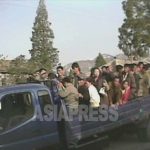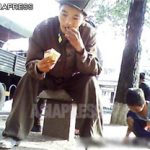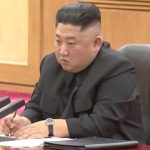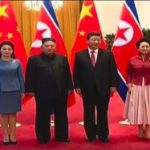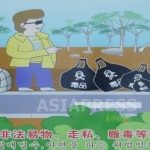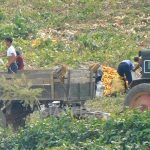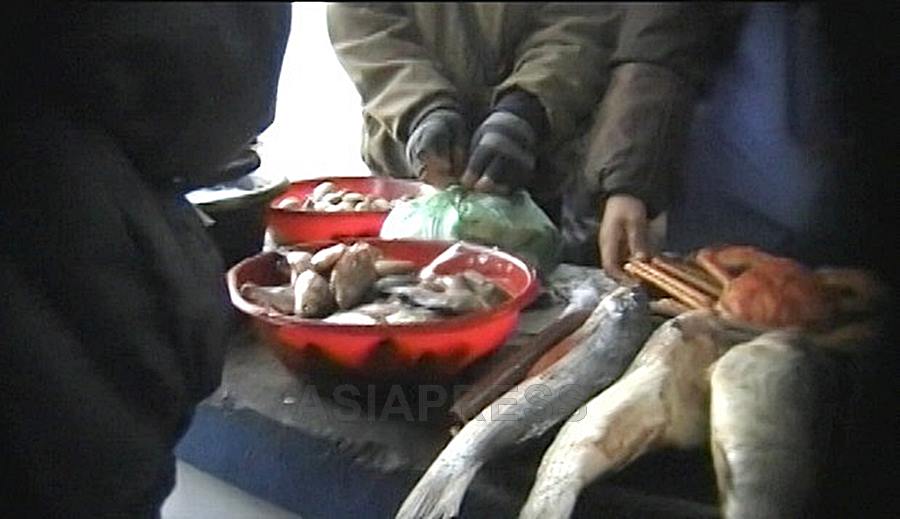
The third installment of ASIAPRESS’s reporting on North Korea’s fishing industry focuses on the types of seafood being sold to end-consumers and what prices they are paying for seafood products. Both markets and state-run food shops are selling seafood that would be familiar to people in both Japan and South Korea. (KANG Ji-won / ISHIMARU Jiro)
◆ What was surveyed?
ASIAPRESS’s survey, which was conducted from late November to early December, involved reporting partners in North Hamgyung and Yanggang provinces exploring three areas: 1) the fishing situation in the East Sea region; 2) the state of transport and distribution of seafood; and 3) the cost of various seafood in markets. The reporting partners were unable to visit areas with seaports due to severe restrictions on their movement; however, they made domestic phone calls to people working in the fishing and seafood industries and met with local business people involved in seafood sales. The survey was able to garner information about the situations in Chongjin, Kimchaek, Myongchon County, and Hamhung (South Hamgyung Province). The survey was unable to gather information about the situation on the West Sea.
◆ The Kim Jong-un regime intends to revive the state-run food shop network
Reporting partners in a city in North Hamgyung Province and Hyesan, Yanggang Province, surveyed prices of seafood in state-run food shops and public markets.
Over the past several years, the Kim Jong-un regime has been intensifying state control over the distribution of goods. Seafood businesspeople are being ordered to sell their products to state-run food stores through the government distribution network. Market sellers, meanwhile, are required to purchase seafood wholesale from state-run food stores to sell.
In general, market sellers must purchase seafood at wholesale prices set by state-run food stores, except in cases where the products are spoiled or have passed their sell-by date. Compared to the past, it has become difficult for market sellers to freely purchase and sell products as they wish, which has led to falling profits and an increase in people leaving their market seller jobs. Meanwhile, state-run food shops are failing to keep stable stocks of seafood on hand; there are times when massive stocks are available at the stores while, at other times, stocks are depleted.
〇 Hyesan
| Type of Seafood | Price (North Korean Won) | Type of Seafood | Price (North Korean Won) |
| 2 mackerel | 3,000 | 2 pollack | 10,000 |
| sandfish (1kg) | 2,100 | 2 trout | 8000 |
| herring (1kg) | 6,100 | crab (1kg) | 24,000 |
| 2 flounders | 5,000 | dried squid (1kg) | 6,1000 |
〇 City A, North Hamgyung Province
| Type of Seafood | Price (North Korean Won) | Type of Seafood | Price (North Korean Won) |
| 2 mackerel | 3,200 | 2 pollack | 9,000 |
| sandfish (1kg) | 2,400 | 2 trout | 7,500 |
| herring (1kg) | 5,800 | crab (1kg) | 23,000 |
| 2 flounders | 5,200 | dried squid (1kg) | 58,000 |
A table showing the prices of seafood in state-run shops and markets. Based on a survey conducted from late November to early December 2023. (ASIAPRESS)
◆ The prices of eight kinds of seafood…very low compared to South Korea and Japan, but…
In terms of the types of seafood on sale and their prices, there are no major differences between state-run food shops and public markets. At the time of the survey, the only seafood available was that caught in the East Sea. All the available products were dried or salted seafood products; there were no fresh fish available. It was unclear from the survey how large the fish on sale were or the types of crabs available. Dried squid was expensive because of a continuing scarcity of squid available to catch.
Below is a list of prices surveyed from late November to early December. All prices are in North Korean won. The survey was conducted at state-run food stores and public markets.
〇Hyesan
2 mackerel 3,000 won; sandfish (1kg) 2,100 won; herring (1kg) 6,100 won; 2 flounders 5,000 won; 2 pollack 10,000 won; 2 trout 8,000 won; crab (1kg) 24,000; dried squid (1kg) 61,000 won
〇 City A, North Hamgyung Province
2 mackerel 3,200 won; sandfish (1kg) 2,400 won; herring (1kg) 5,800 won; 2 flounders 5,200 won; 2 pollack 9,000 won; 2 trout 7,500 won; crab (1kg) 24,000 won; dried squid (1kg) 58,000 won
※ 1,000 won in North Korea is equivalent to approximately 164 South Korean won.
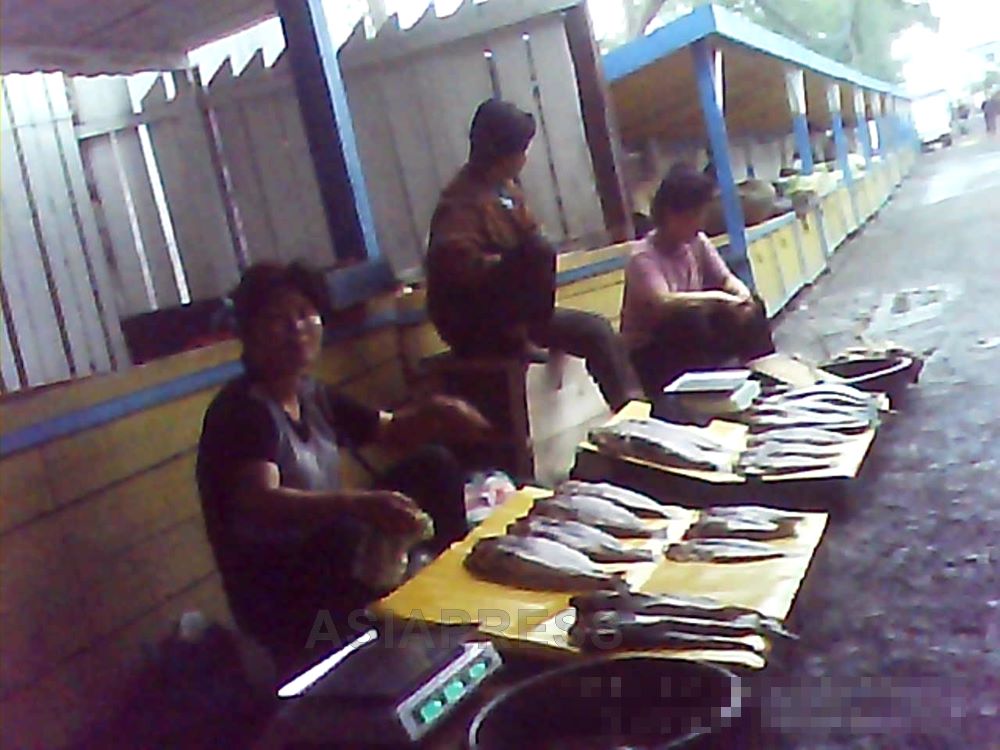
Compared to prices in Japan and Korea, the above prices are very cheap. However, from the perspective of North Koreans, prices have risen compared to before the pandemic. During the survey period, white rice was going for 5,000 won per kilogram and corn was selling for 2,000 won per kilogram. “It’s natural that many people think (seafood prices) are expensive compared to other food prices because their lives are so difficult economically,” a reporting partner in City A told ASIAPRESS.
The Yanggang Province reporting partner told ASIAPRESS that “freshwater fish and farmed mudfish are selling well because they’re cheaper than salt water fish.”
The reporting partner who conducted the survey in Hyesan said: “The most popular seafood has been caught by fishing companies in Hamhung, Kimchaek, and Myongchon on the East Sea coast.” This may be because Hyesan, which is near the border with China, does not have good logistics routes with the Yellow Sea on the west coast. City A in North Hamgyung Province, meanwhile, is close to the East Sea coast, so seafood caught by the major fishing companies in Chongjin and its environs are popular. (End of series)
※ ASIAPRESS communicates with reporting partners through Chinese cell phones smuggled into North Korea.
<Investigation Inside N. Korea> How is the country’s fishing industry doing? (1) COVID and shrinking fishing grounds major problems…Kim regime’s restrictions on fishing lead some fishermen to financial collapse
<Investigation Inside N. Korea> How is the country’s fishing industry doing? (2) Distribution of seafood faces challenges due to severe government restrictions…Why are private businesspeople unable to distribute their goods?
- <Interview> How was the public execution in Hyesan carried out?…In just four months, three executions have occurred in the city… “We were lined up at our places of work and marched to the execution site”
- <Urgent Report> Public execution takes place again on December 19, the third in Hyesan this year…large numbers of people mobilized to witness event
- <Inside N. Korea> The government distributes coal as winter sets in…, but only 15% of what people need…Robberies of firewood and coal are common
- <Inside N. Korea>Bootleg liquor is an anti-state act The government launches harsh crackdowns, aims to monopolize distribution of alcohol and prevent shortages of grain
- <Inside N. Korea> A year after “Kim Ju-ae“ ’s first appearance, what kinds of things are people saying about her?
